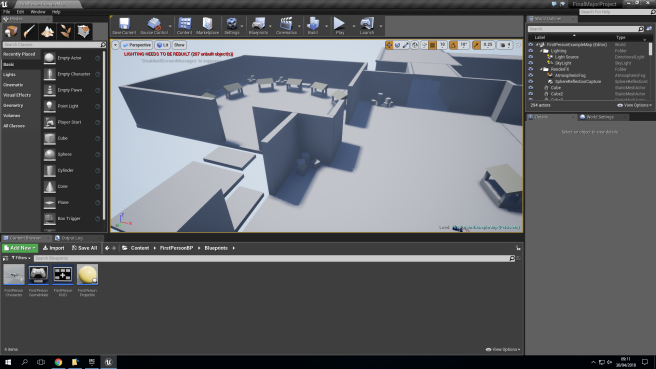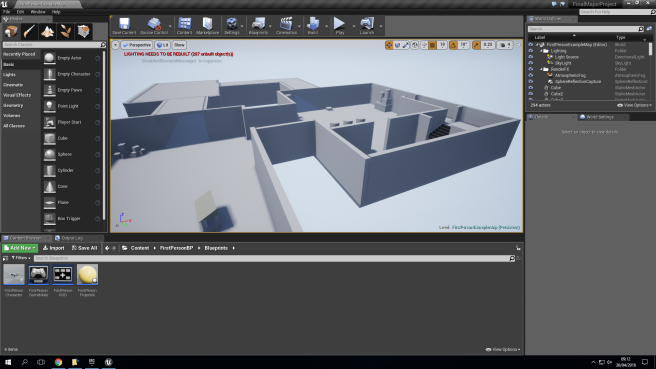The main thing that I have learnt from this course is that I am not interested in pursuing a career in the games industry. I have considered following up a different course, something with a more creative side like music or art. If not then I shall just have to get a job to get some amount of income to support my other pursuits such as various kinds of arts. Preferably I would be able to do both.
FMP Evaluation
My map is a steampunk inspired sky docks kind of thing. My plan I drew up vaguely covers the basic layout of the area as well as showing where the spawn points and capture points are. There are at least three basic sub-areas within the level. The market, maintenance and the docks themselves, as well as different routes between the areas (one of which being a corridor with a small storage area). Looking at the final product, the steampunk aspect did not come through as well as I had planned. The only things that hint at it are the pipes and the cogs. I think the reason this happened is that I didn’t plan what the level would actually look like in enough detail, so when it came to making the level I had to make it up on the spot. Originally I had drawn up a different map idea, which I ended up not using as the idea was too large, it wasn’t tailored towards a specific map type and there wasn’t enough overall direction. The second plan I drew up was done in Photoshop.
Another thing that didn’t quite go as planned was the different sections. I think this was something else that suffered from a lack of planning. The different sections don’t feel like they’re clear enough as to what they are intended to be, especially the docks area. They all seem quite empty. While there was some items placed around (for example there were quite a few crates and tables). To make the different sections more defined I think I could have added more items that would be specific to those certain areas. This experience again showed that I needed to have planned the level more.
One of the few things that did go as planned are the crates. They turned out just as I imagined, and helped to fill out the area. However as I put them in every area they didn’t help to differentiate between the different areas. I unfortunately, due to not having made more models had to use the two variations of the crates to fill up the space. Without them it seemed far too empty. The texture was just something that was put on as a temporary thing, however it ended up being the final texture. I was going to create another texture however it didn’t end up happening.
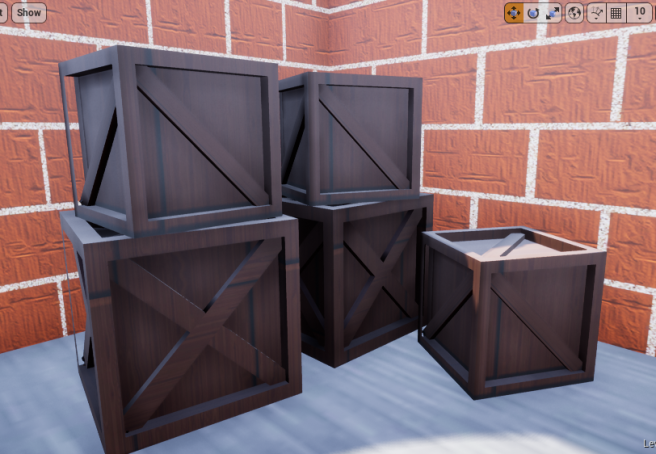
Another thing that went well was the cogs. They were a later addition, however they are essential in reinforcing the steampunk theme. They also add an aspect of movement to the level which makes it seem much more alive and real. The texture for the cogs could have been more metallic and more detailed, and again there could have been more variety. The reason that there wasn’t much variation was that the cogs were added later as I already have stated. The reason I added them later was because I didn’t plan the level well and was running out of time. Also, I needed to add something else to make the steampunk theme more prevalent.
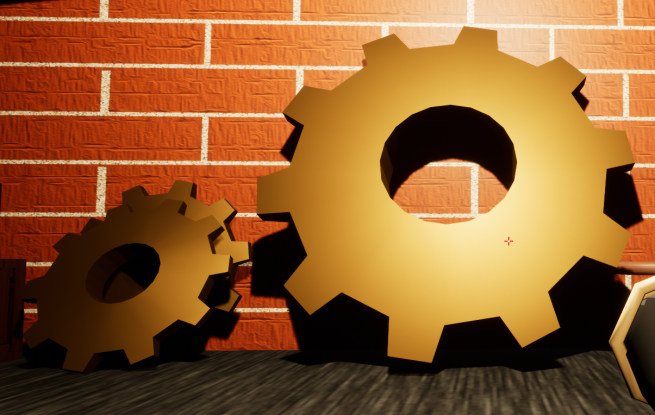
The market stalls were also very helpful in defining the different areas (the market area and the docks). However I think if I had planned what the market stalls look like then the final product may have been better. As they are now, the texture is not very steampunk (it is just a basic wood texture that covers all of the 3D model). That is a problem throughout the entirety of the level however, with the textures not looking very steampunk. It is one of the main reasons that the map doesn’t look very steampunk.

The tables are another thing that have a basic wood texture, which takes away from the intended overall steampunk aesthetic. If it had had a more steampunk/scrap metal texture then it might have fit better. However they still help to fill up the area so they are still useful in the grand scheme of the whole level, and making it seem like its not just an empty warehouse. They also could have had more variety with the model and the texturing.

Another part of the level that had potential to add to the steampunk theme however was let down mainly by the texture is the machines in the maintenance area. If they had had a better texture then they could have come across better however they suffered due to a lack of planning and a lack of skill with texturing. The pipes help to add to the steampunk feeling, as they have a nice metal texture and are placed around in a steampunk way.
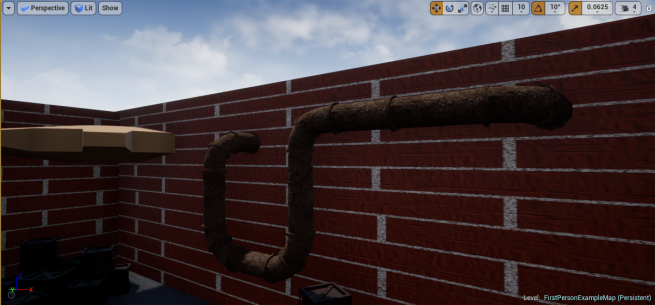
The walls have a basic brick texture, which with the right additions could have set up the area well but on their own did not quite achieve the right feeling. They had a brick texture which is what I wanted, however just the brick texture on its own didn’t quite convey the steampunk aspect across quite well enough. However, the later addition of pipes and cogs, did help to reach my original vision somewhat but not entirely. The brick wall texture also often was stretched in places and in others didn’t line up with other walls, but that is just down to my lack of ability.

The floor was really where the basic area fell down. Again a lack of planning made the final floor texture seem unsure of what it is trying to be – it ends up looking like a marble work surface from a kitchen. I think to solve this problem I could have done more research into what kinds of floors are usually found in the kind of steampunk environment I was going for, which I then could have applied to my own level. I personally feel that the floor was one of the biggest shortcomings of the map.
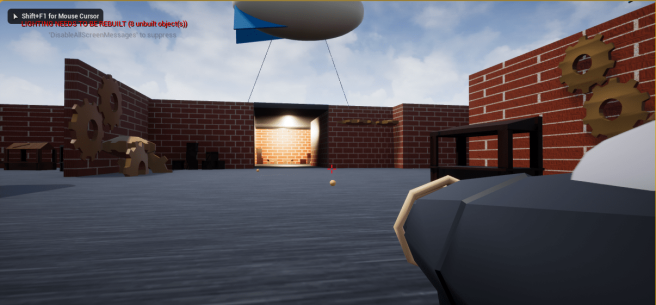
At the end of year media show I received various kinds of feedback for my level. Despite my own reservations about whether or not the steampunk aspect came over at all, people seemed to understand for the most part that that is what I was going for. Of course I’m glad that people could tell however I am surprised that they could, as when I looked at it I felt like it didn’t really seem very steampunk. Some students questioned why I used the techniques that I did to create my level. My choices of technique weren’t so much by choice, rather a lack of knowledge on my part. This feedback is fair enough, I agree that I could have put more work into getting better with various parts of the game making process, for example texturing which is often the reason my level didn’t quite reach my original vision. There were also some issues with the 3D models, inverted textures that I got questions about. I had noticed these problems however I didn’t have the time or knowledge to fix them, so I agree with this feedback. Had I had more time I would have fixed these things. I also got asked about what various models actually were, which I believe was mainly due the textures. A lot of the textures were reused from other things, for example the wood texture for the table was reused for the market stalls and was re-coloured in various types of metal and were used for the machines and the floor. I agree with this feedback as well. The strong point of my map is most certainly not the textures. Also there could have been a stronger theme in general. I was going for a steampunk theme which didn’t quite come across as well as I had hoped and originally planned. This could have been solved by adding in more steampunk related objects and textures. Another issue was the amount of variation in the map. There were not many different models which meant that the entirety of the map suffered for it, and it created many complaints and comments from people. I would have made more variation in the map but I was running out of time and I had to prioritise what tasks needed to be done. Different things like the pipes and the cogs and machines could have had more variation. Overall the feedback I received for my level was all pretty much warranted, and was often things that I had already noticed but didn’t have the time or knowledge to fix them.
Overall the whole thing feels like it just about fell short of the steampunk theme. With a few corrections and additions here and there it could be much more accurate to the original plan. Things like the floor and the textures of the machines, tables and market stalls are some of the biggest areas that would need improving and changing. However the cogs and crates helped make it steampunk, and the overall map layout and design somewhat makes up for the less than fantastic textures. All in all, it has promise however some odd things here and there make it fall just short of the mark.
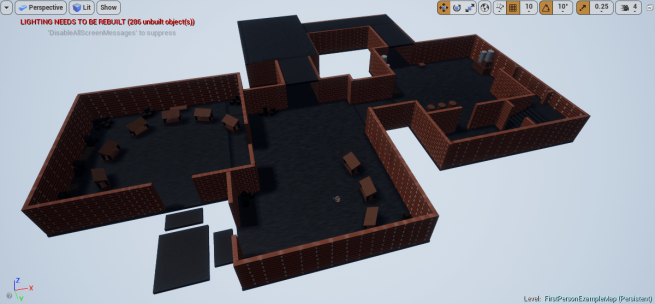
FMP Production Log – Week 6
- Put the reload animation into unreal
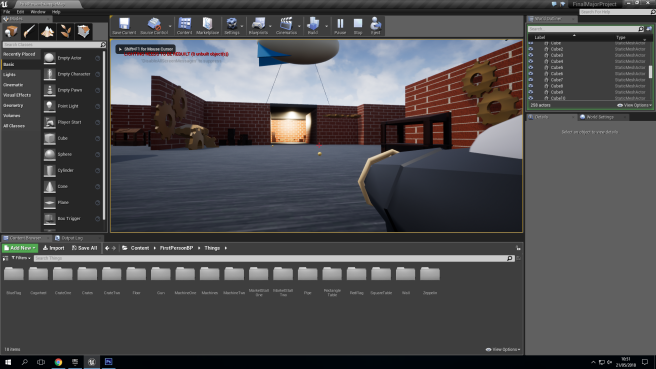
2. Added in flags for the spawn points and the capture points
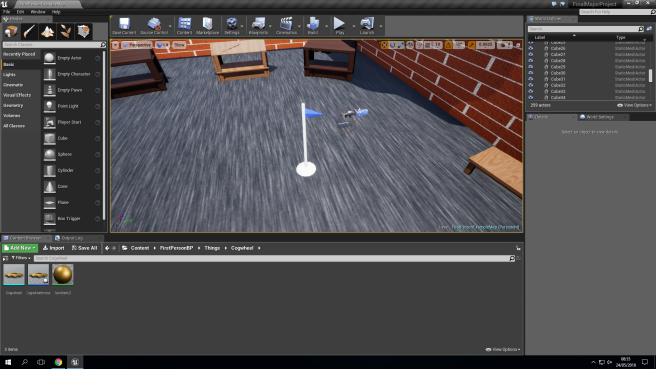
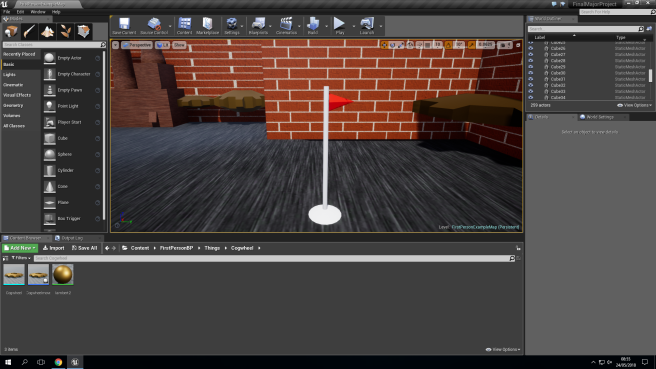
3. Added some particle effects
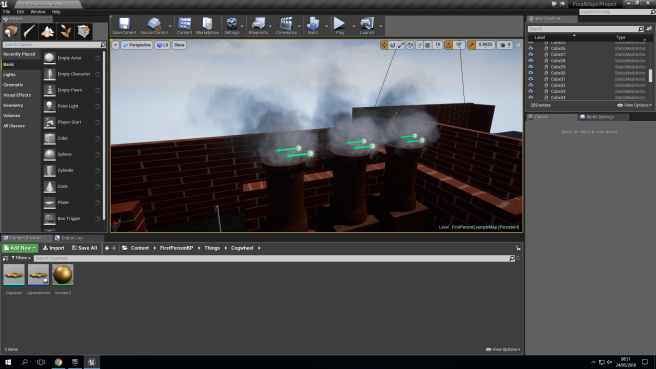
4. Changed the gravity and speed of the projectile
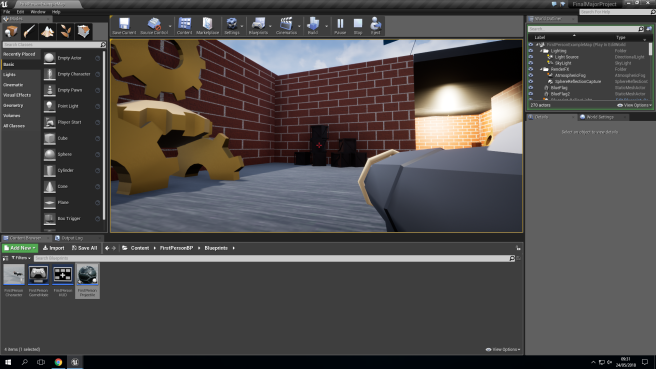

FMP Production Log – Week 5
- Put gun into unreal
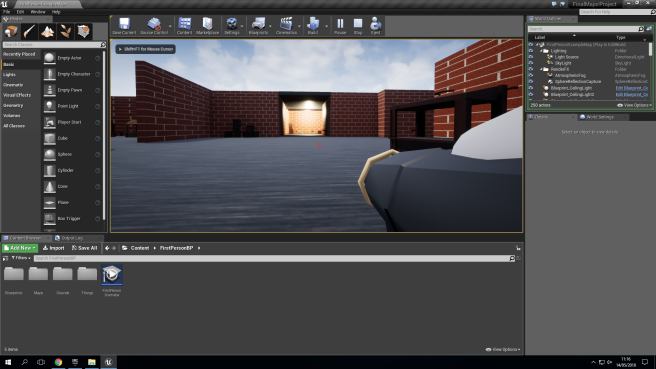
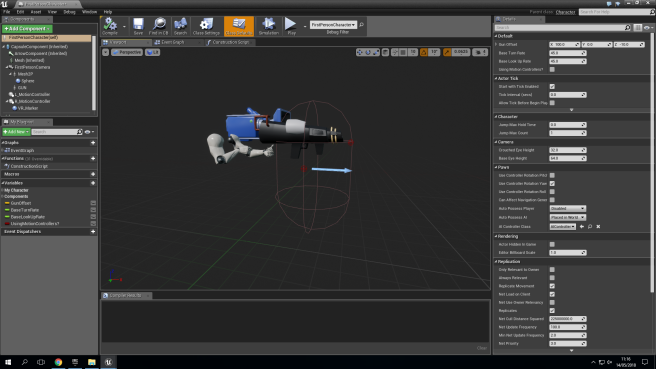
2. Put cogwheels and pipes into unreal
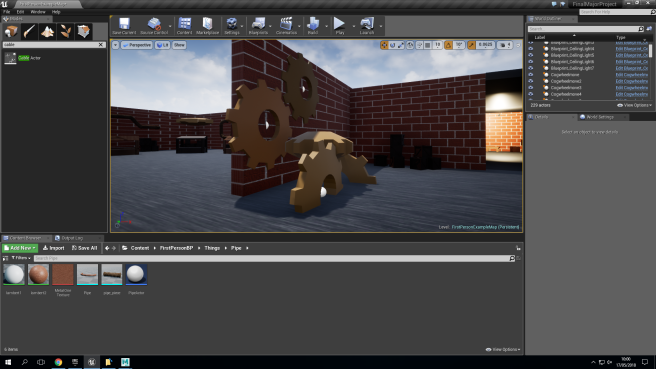

Creating 3D Models
Application of 3D Models
All the time there are more and more applications of 3D in a variety of fields and industries. In some areas such as architecture and engineering advances in technology mean that 3D is becoming much more relevant to these kinds of industries. In others like video games, certain kinds of films and TV shows 3D has always been relevant to a certain degree, especially for video games. With technology improving all the time, 3D is only becoming better and better. In films and TV shows, such as Doctor Who and the Harry Potter film series, 3D plays a huge part.
Displaying 3D Models

Occlusion Culling
When the game only renders what the player is looking at. The render changes as the player looks around. A problem with this is if the player moves too fast they may beat the rendering time and see things spawning in.
Level Of Detail
When the distance from an object determines the level of detail that the objects renders. The closer the player is to the object, the higher the level of detail would be. A problem here is if the game doesn’t render the object to a higher quality quick enough it can lead to the player seeing the item when it is in a lower quality state.
Fogging
When the game loads a layer of fog to hide the fact that it hasn’t rendered beyond a certain point. It is usually a subtle fog, different to the kind that adds an effect to the atmosphere of the game. If the fog is too intrusive it can ruin some players experience of the game.
Geometric Theory
Face – The face of a 3D shape is a flat surface on one side of the shape.
Edge – An edge is a line that joins the two vertices.
Vertex – A vertex is a corner of a shape.
These are things that are altered and edited to create 3D models.
Mesh Construction
How do we make 3D models (e.g. primitives, extrude, bevels, connect, edge loops)
There are many different things to consider when making a 3D model, and many tools to use. Some are the extrude tool (which allows faces to indent a shape into an object or for faces to be drawn out of a shape), bevels (which adds a sloped edge to a shape), connect (which connects two different shapes or lines) and edge loops (which adds another line to a shape).
3D Development Software
There are various different options for 3D modelling software. Each have their own pros and cons. Some examples are Maya, Blender, Z Brush, 3D Coat.
Constraints
There are also constraints to creating 3D models. One is the poly count, which is ideally kept as low as possible, otherwise the file size will be too big, which would be another problem. There are often minimum hardware requirements to be able to run most 3D modelling programs. As well as these things, the file type is also important, as some game engines only take certain file types that some 3D modelling programs might not use.
FMP Production Log – Week 4
- Made some more textures
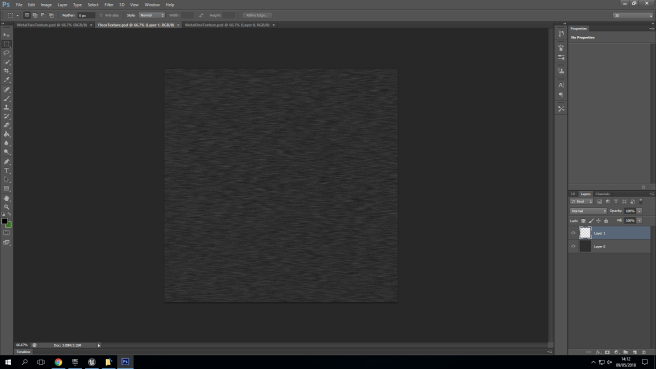
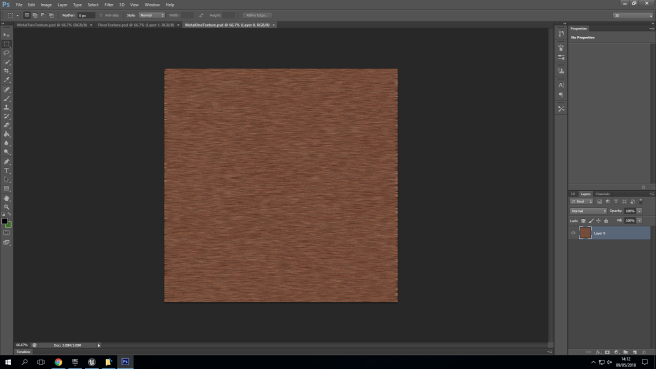
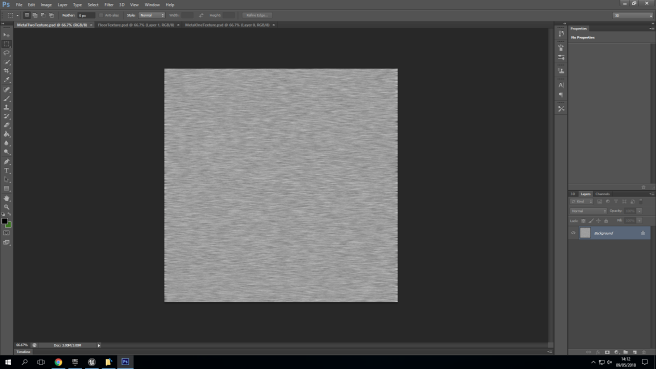
2. Applied the textures to items in unreal

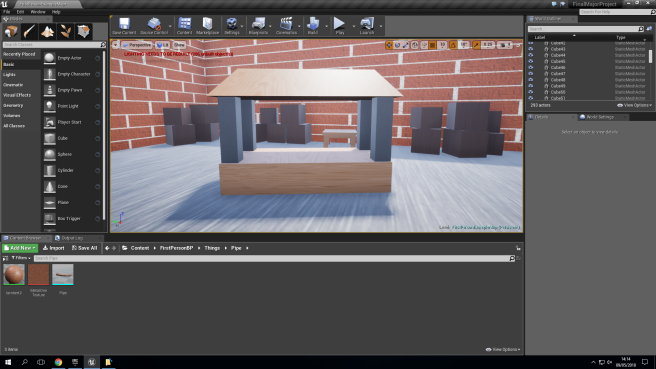
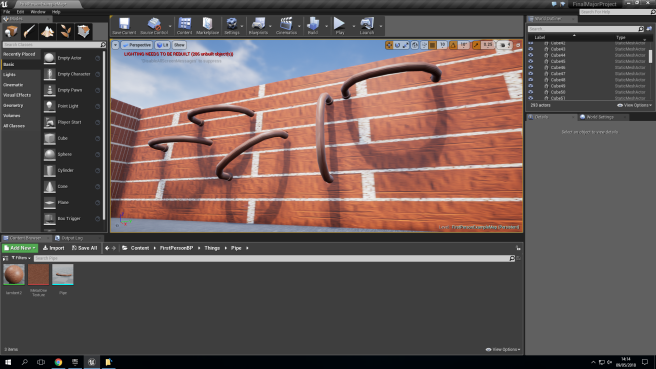
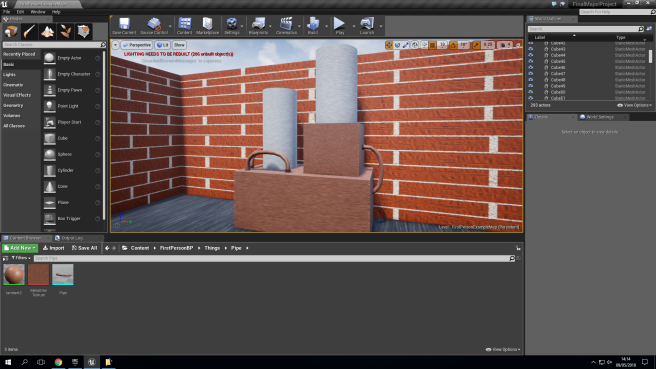
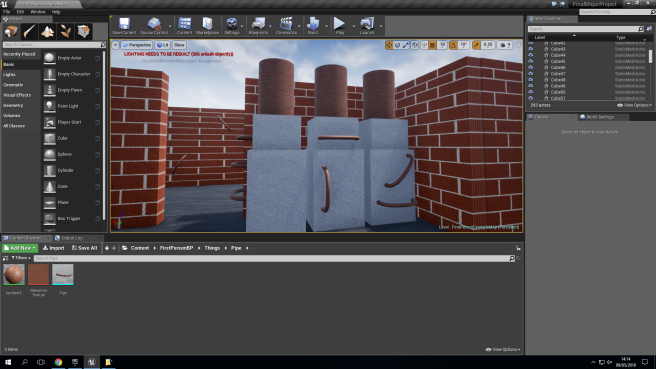
3. Replaced the blockout in unreal
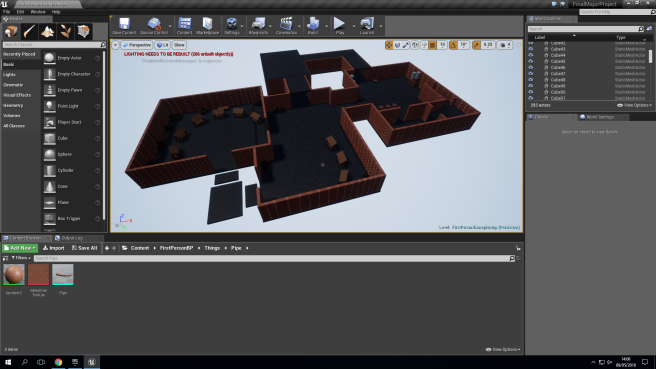
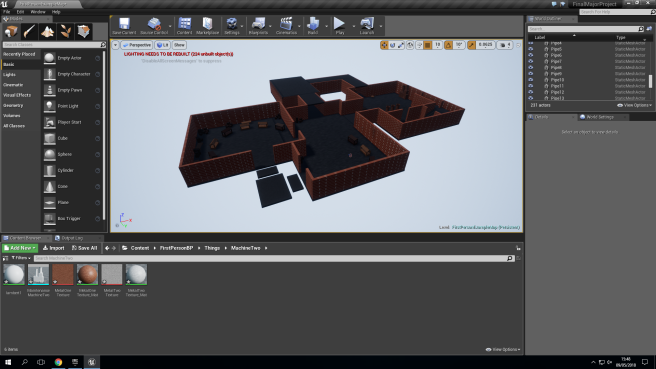
Game Engines
Graphics
What is a game engine?
A game engine is the basis of a video game, the software that everything is built around. It handles many things, such as;
- Graphics
- Physics
- Sound
- Animation
- Scripting/Compiling
- AI
Some examples of game engines are Unreal Engine 4, Unity, Frostbite and GODOT.
Types of game engines
Some game engines are owned by game companies and are therefore not available for public use. Some others are open source and are available for public use.
Purpose of game engines
Game engines are convenient as they handle multiple parts of a video game, which makes it easy to edit and manage the various parts of the game, and it streamlines the production process.
Graphics in game engines
There are multiple things that go into rendering graphics in games, various different inputs giving out different information such as lighting, distance and what is in view. Occlusion culling is when the game doesn’t render what the player can’t see in order to improve running speeds of the game. Lighting is also managed by the game engine.
Animation
Spline Animation
Spline animation is a way of making AI in a video game follow a certain path. An example of it is in side scrolling games set in a 3D environment.

Kinematics
Inverse kinematics is the way that characters are animated in video games. It allows the developer to program a character to move like a real person. However it takes a while to set up. Forward kinematics works in the opposite way to inverse kinematics.
Particle Systems
The particle system that Unreal Engine 4 uses is called Cascade. A particle system is used to create effects like fire and muzzle flashes. Various different particle systems have control over various different parts of the particles such as duration,
AI and Other Systems
AI (Artificial Intelligence) is what game engines use to make the video game world seem alive. It tells the other characters of the world what to do, how to interact with the player and the world. Unreal Engine 4 uses the A* algorithm and EQS for AI. The A* algorithm handles pathfinding, which is required for the AI to move about. Behavior trees are also used for coding these things (using roots selectors and sequences). Using these systems the game engine can make the AI walk to a specified or random location, talk/interact with the player or other AI, attack and have daily routine.


Collision Systems
Collision systems are largely based around the shape of objects. For example convex objects are a lot easier to work with than concave (convex being “out” and concave being “in”). The reason that games have to load before you can enter a building is because collision systems only really work well with convex shapes rather than concave ones.
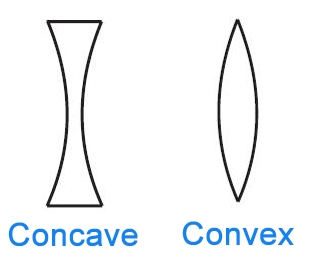
Middleware
Middleware is software made by other people, usually for a specific purpose. Unreal Engine 4 uses a lot of middleware, such as PhysX by Nvidia (a physics engine), substance painter (a program that can make realistic textures), SpeedTree (a program dedicated entirely to making trees and World Machine (a program used for creating landscapes).
FMP Production Log – Week 3
- Made some more 3D models.
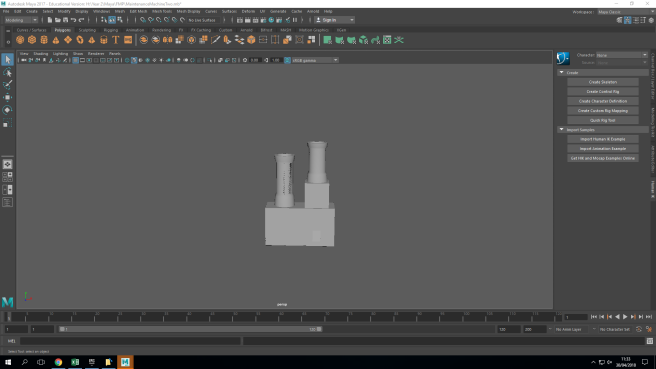

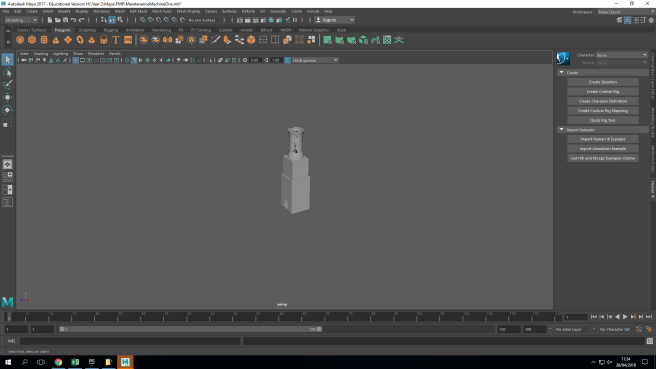

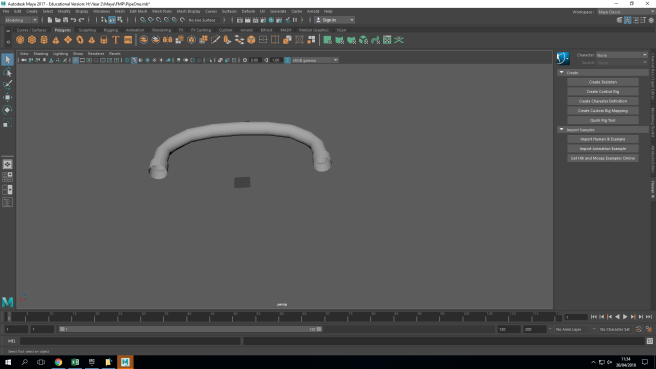
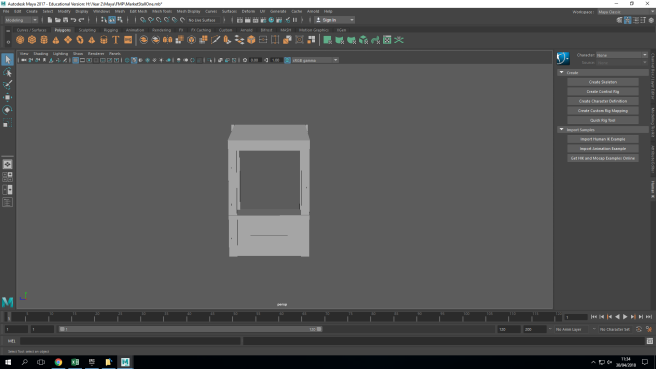
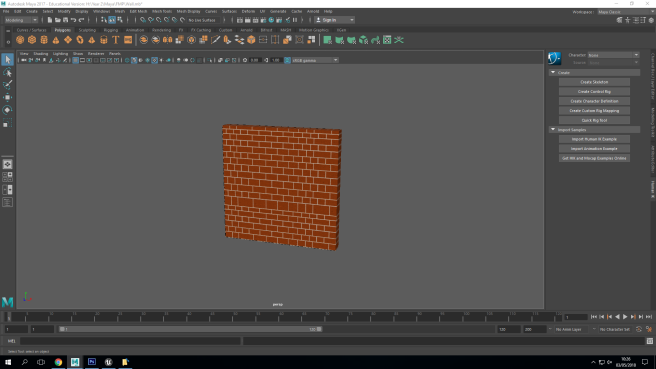
2. Made some textures (brick wall, Wood textures)
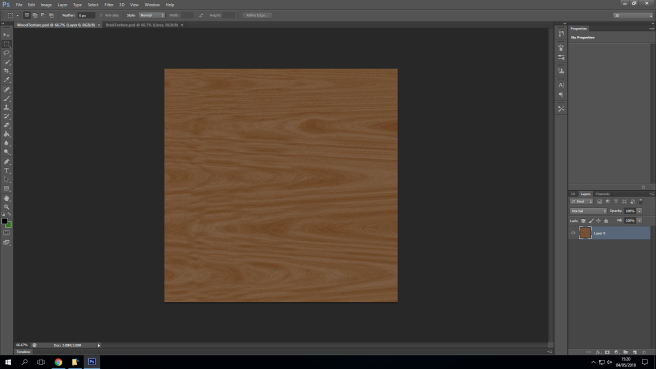
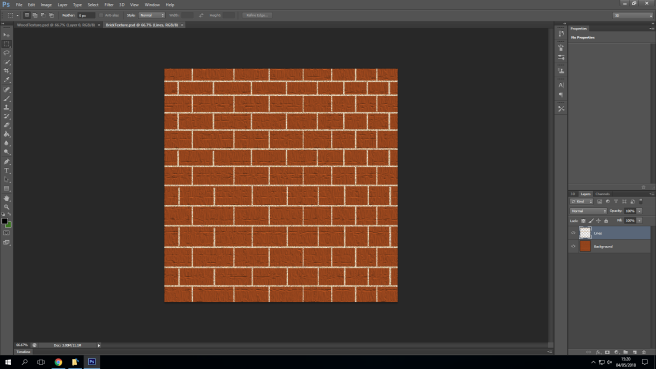
3. Applied them to the objects
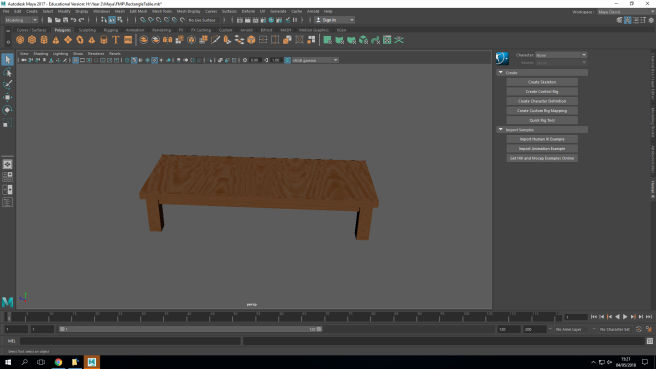
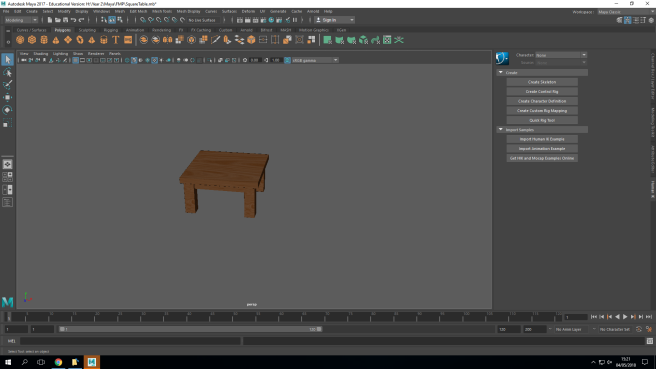
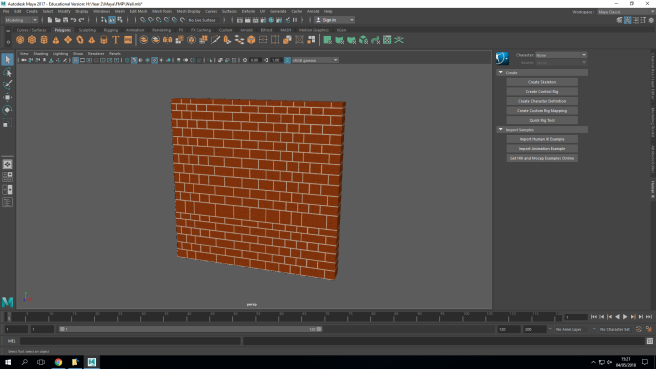
4. Put them in unreal
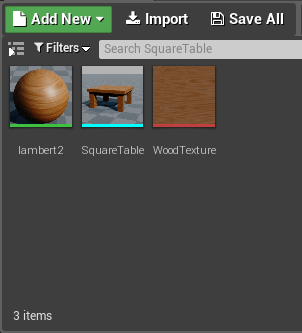
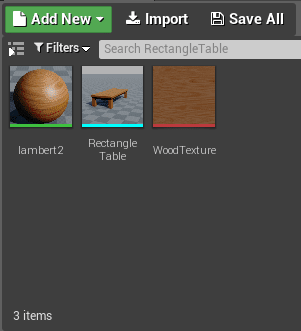
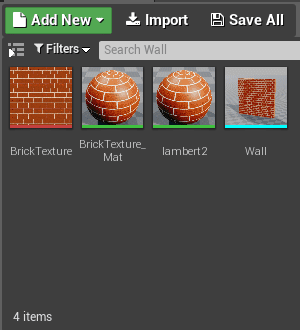
FMP Production Log – Week 2
- Made a list of the required models.
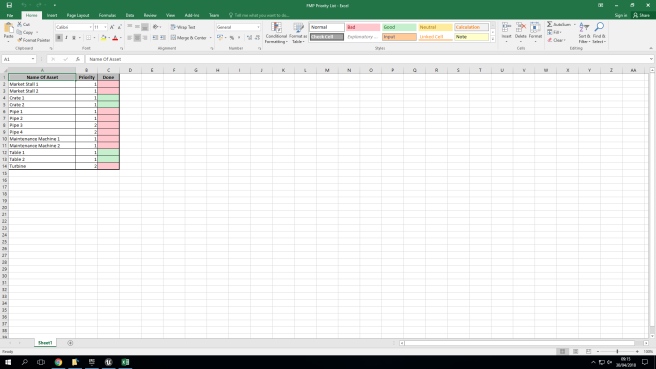
2. Made some of the 3D models.
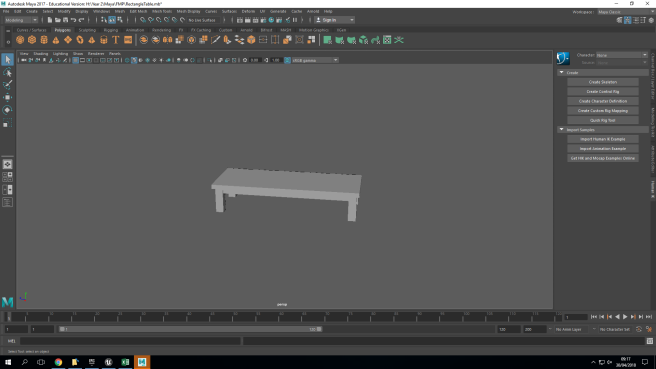

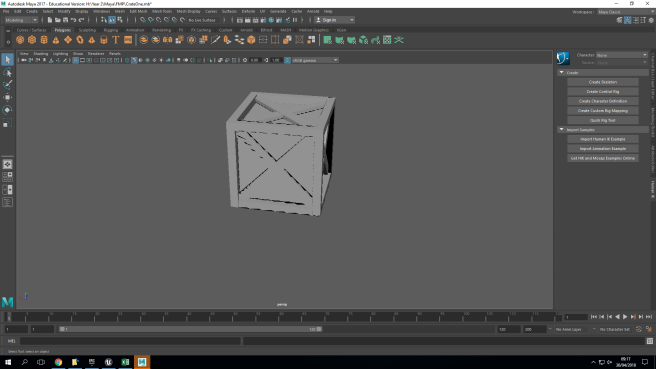
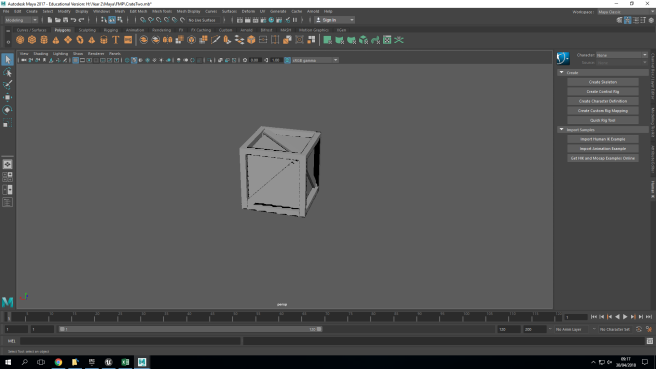
FMP Production Log – Week 1
- Did the block out for the level.
